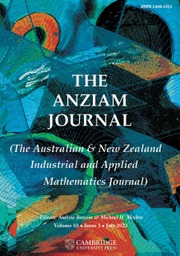No CrossRef data available.
Article contents
CONSTRAINED FRACTIONAL OPTIMIZATION PROBLEMS AND CORRESPONDING SADDLE-POINT OPTIMALITY CRITERIA
Published online by Cambridge University Press: 23 October 2025
Abstract
This research introduces an adapted multidimensional fractional optimal control problem, developed from a newly established framework that combines first-order partial differential equations (PDEs) with inequality constraints. We methodically establish and demonstrate the optimality conditions relevant to this framework. Moreover, we illustrate that, under certain generalized convexity assumptions, there exists a correspondence between the optimal solution of the multidimensional fractional optimal control problem and a saddle point related to the Lagrange functional of the revised formulation. To emphasize the significance and practical implications of our findings, we present several illustrative examples.
MSC classification
Information
- Type
- Research Article
- Information
- Copyright
- © The Author(s), 2025. Published by Cambridge University Press on behalf of the Australian Mathematical Publishing Association Inc.


